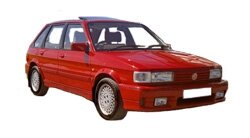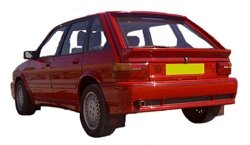Model Page
Austin MG Maestro Turbo

|
Production Run: |
505 |
|---|---|
|
Production Date: |
1989 - 1991 |
|
Engine: |
Austin / Rover 2.0 4 Cylinder |
|
Built: |
Cowley (UK) |
|
0-60: |
6.7 Secs |
|
Max Speed: |
129 Mph |

The MG Maestro Turbo was a limited production edition of the Austin Maestro, fitted with a 2.0 Turbocharged engine the car could reach around 130 Mph and achieve 60 Mph from standstill in well under 7 seconds. Austin was keen to promote the performance capabilities of the car and marketed the car as “Being faster than a Ferrari”, this claim was made as the Ferrari Mondial had a 0-60 sprint time of 7 seconds.

MG Maestro Turbo Front Profile
Between 1984 and 1985 Austin Rover embarked on an initial testing program to ascertain as to whether the front wheel drive Maestro chassis was capable of handling the extra power that a turbo charged engine provided. Journalists had approached Harold Musgrove the then chairman in 1985 enquiring about the project, he confirmed the vehicles existence but stated that Austin Rover had no plans for production.
Contrary to this development of the Turbocharged Maestro continued, engineering of the vehicle was a joint effort between Austin Rover and Tickford. Having worked on projects such as the Tickford Capri Turbo, Tickford had a track record of engineer and co-manufacturing special edition cars based on regular production models. Tickford designed a bespoke 5 piece body kit that consisted of large front bumper / spoiler with integrated Lucas sourced auxiliary driving lamps and a large rear bumper, a rear tailgate mounted spoiler and new side skirts. The visual revisions were completed through the application of large “Turbo” decals adorning the side of the car and colour coded wing mirrors and grilles.
The Maestro Turbo was fitted with a 1,994cc in line four cylinder eight valve single overhead cam O series engine that had a cast iron block and aluminium head, the engine had a bore of 84.5mm and stroke of 89.0mm with a compression ratio of 8.5:1. The power-plant was fitted with a breaker-less electronic ignition and single choke side draught Weber Carburettor. The performance potential of the unit was increased through the installation of a Garret T3 Turbocharger and an air to air intercooler that was fitted between the SU HIF44 Carburettor and air filter housing. The carburettor was mounted at 35 degrees to a unique inlet manifold that had short inlet tracts designed to improve the response gained by the Turbo. Fuel was delivered to the Carburettor via a high pressure Bosh fuel pump. In this specification the unit developed 150 bhp @ 5,100 rpm and 169 lb/ft @ 3,500 rpm.
The car was fitted with the same running gear as was equipped the MG Montego Turbo with independent front suspensions made up of MacPherson struts with lower wishbones and coil spring and a 22 mm anti-roll bar. The rear suspension was made up of a semi independent torsion beam axle with rear trailing arms, coil springs and an anti-roll bar. The dampers front a rear were gas filled units under high pressure. Tickford developed the suspension refining the setup to deliver safe predictable handling with a good ride, the spring rates were raised by 11% at the front and 25% at the rear and a 10% thicker anti-roll bar was fitted to the front. Power was transferred to the front wheels through a five speed close ratio manual gearbox – automatic transmission was not an option. Braking was upgraded with servo assisted 9.5” ventilated discs at the front and 8.0” drums at the rear. Steering was taken care of by a power assisted rack and pinion unit that required 3.5 turns lock to lock. Braking was upgraded from the standard Maestros with 241mm ventilated discs at the front and 203 mm drums at the rear these being fed by a diagonally split dual circuit with servo assistance.

MG Maestro Turbo Rear Shot
Production was not a straightforward affair with production split across two sites. First the cars were assembled alongside regular production Maestro’s at Austin Rovers production facility in Cowley but the car did not receive dumpers, rear tailgate spoiler or badging. The incomplete cars were then transported to Tickford’s factory at Bedworth for the unique bodykit and decals to be fitted before being transported back to Cowley for commissioning. The car was available in a range of only four colours – Flame Red, Metallic Green, Black and Diamond White, of these 215 vehicles were produced in Red, 149 in British Racing Green, 92 White - the most rare colour produced was Black. The exterior was finished off with 5J x 15” Alloy wheels fitted with 185/55 rubber.
The car featured an upgraded interior featuring a three spoke leather steering wheel, MG instrumentation binnacle with speedometer, tachometer and digital clock. A tilt and slide sunroof, central locking electric heated door mirrors, electric windows were all standard fit. The seats were trimmed with Marle Deco and Plain Velour trim with a smart red piping finish.
The car was previewed at the British Motor Show in October 1988 before finally going on sale on 17th March 1989, the car was launched at £13,529 and at the time was the fastest front wheel drive production car on the market. Sales were slow in part due to the model being released so late in the model lifecycle – in fact six years after the original launch, the cost and to some degree the competition the car was up against such as the faster, more refined Sierra Cosworth.
The Facts
|
Engine: |
Austin Rover O Series In Line 4 |
|---|---|
|
Capacity: |
1,994cc |
|
Valves: |
8 |
|
Compression Ratio: |
8.5:1 |
|
Fuel System: |
SU HIF44 Carburettor |
|
Maximum Power: |
150bhp @ 5,100 rpm. |
|
Maximum Torque: |
169lb/ft @ 3,500 rpm. |
|
Transmission: |
Manual 5 Speed. |
|
Top Gear: |
- |
|
Brakes: |
Servo Assisted Ventilated ront Discs / Rear Drums |
|
Kerb Weight: |
1087 Kg |
|
Max Speed: |
129 Mph |
|
0-60: |
6.7 Secs |





